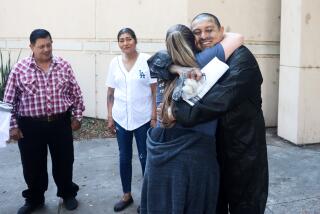Facts, not furor
Few tragedies compare to the death of a child, and in Los Angeles County, too many children die at the hands of parents or caregivers.
But in Los Angeles there is an additional disgrace: the fueling of panic over child fatalities by government officials and the news media, who continue to operate in an environment clouded by incomplete and misunderstood facts.
Are child deaths related to the Department of Children and Family Services rising precipitously? What data do we have, and what is the context? What does the data really show about the policies of the DCFS? Answers to these questions are getting lost in the furor surrounding reports of child deaths in the news media and at Board of Supervisors meetings.
News reports and officials have done little so far to put the current level of fatalities in perspective. As we see it, these are some of the fundamental sources of confusion:
The term “child death” can mean too many things.
Last year, according to the DCFS, 55 children who had department case histories were homicide victims. That fact alone evokes for many an image of an infant or toddler killed in an abusive home, when the DCFS should have spotted danger.
But “children” includes those up to 18 years old. A closer look at the 55 homicides shows that 35 were of teenagers shot or stabbed to death in assaults, many in gang-related incidents. Three youths were shot by police officers.
The label “DCFS history” applies to any child who has been the subject of an abuse complaint; the history remains with the child even if the complaint was found to be false. These children in most cases were not young children, and few were still under the care of the DCFS.
The number of children killed by parents, foster parents or relatives acting as guardians have been effectively constant since the 1990s. These figures have been overlooked.
In 1998, 20 children with DCFS histories were killed by parents, foster parents or relatives acting as guardians. In 2008, there were 14 such fatalities. The number varied from 11 to 20 in the years between. These figures are published in a widely circulated report by the county’s Inter-Agency Council on Abuse and Neglect Child Death Review team, but have been forgotten amid the frenzy surrounding the DCFS.
These numbers are significant for many reasons, not least because of speculation that the DCFS’ emphasis on keeping children with parents or family members, rather than putting them in foster care, has resulted in increased harm to children. But these homicide figures — the most consistent data in hand that cover the period of time since the department adopted its policy of keeping kids in families — do not show that children would be safer in foster care.
The increase in a broader category — “abuse and neglect” child deaths — may or may not be significant in terms of policy decisions. We don’t know yet.
The latest cause for alarm has been a reported jump in “abuse and neglect” deaths of children with DCFS histories, from 18 in 2008 to 26 in 2009. (For 2010, the figure is 21, through August.)
These numbers need context. They include homicides at the hands of parents, foster parents and relatives acting as guardians, but they also include deaths that aren’t considered homicides. There is subjectivity involved in making these determinations, and the definition of “abuse and neglect” has recently been expanded. For example, these numbers now include certain drownings, suicides, deaths from medical neglect and other types of deaths that might previously have been labeled accidental.
It should also be noted that so far we have annual data based on the new definition for only the last two years, a paltry level of comparison. And these are relatively small numbers.
Drawing conclusions from small numbers is always dangerous. A bump from 18 to 26 deaths, in a DCFS child population of about 33,000, is reason for intense scrutiny of the cases, but the increase represents less than .03% of the DCFS’ total caseload.
Any preventable child fatality in Los Angeles County is one too many, and none of this is to say the county’s child protection system isn’t in the midst of a crisis. More oversight is needed. More complete and consistent data must be presented to the public and to the board. We support independent reviews of the DCFS, and we will continue to hold the department accountable, along with other agencies responsible for the well-being of children, the departments of mental health, health, public health and social services.
We must step back from the furor over child deaths and deal with facts. The speculation that the DCFS’ policy — keeping children with family members rather than placing them in foster care — is causing or allowing more child deaths is just that, speculation.
Facts need to dictate how Los Angeles handles its most vulnerable children. Before we call for a major reversal in child welfare policy, one that could lead to a rush of children being taken from their parents prematurely, we need to honestly evaluate where we are today. Evidence, not emotion, needs to fuel the debate.
Mark Ridley-Thomas and Michael D. Antonovich are members of the Los Angeles County Board of Supervisors.
More to Read
Sign up for Essential California
The most important California stories and recommendations in your inbox every morning.
You may occasionally receive promotional content from the Los Angeles Times.










